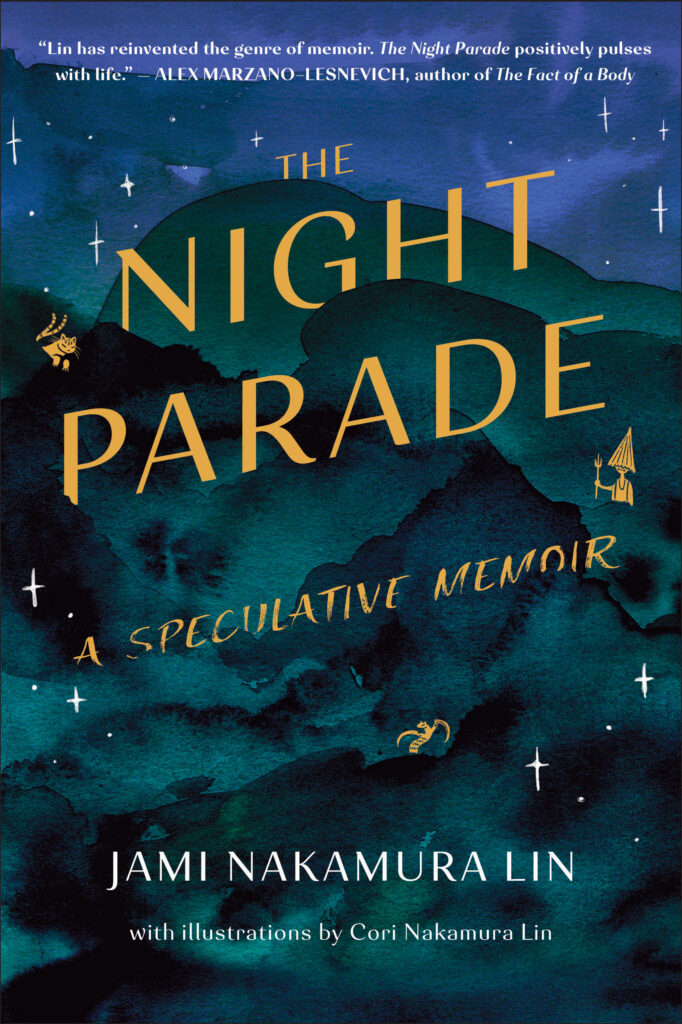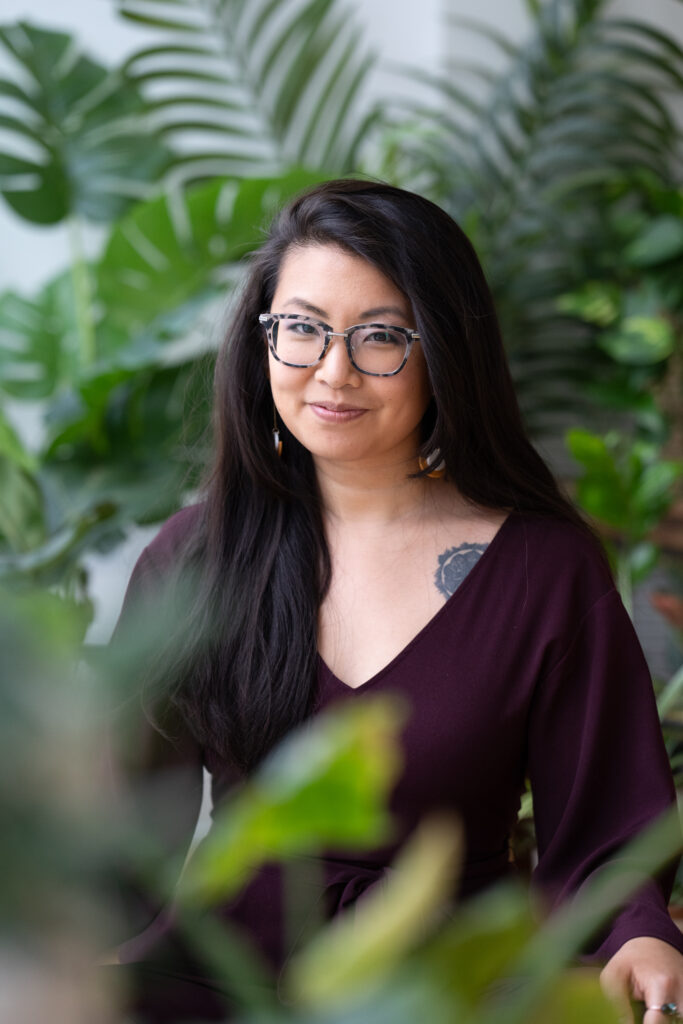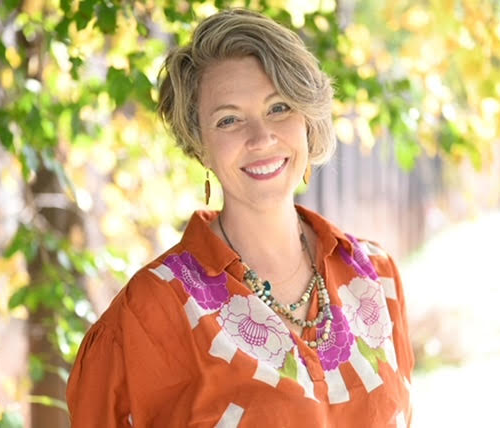Interview by Leslie Lindsay
 Can one create a text that is at once selfish and communal ? Is there a way to merge loss and love? What one writer, devastated by the loss of her father, turns to in a way to reconnect and make sense of her grief, her ancestry, and her mental illness.
Can one create a text that is at once selfish and communal ? Is there a way to merge loss and love? What one writer, devastated by the loss of her father, turns to in a way to reconnect and make sense of her grief, her ancestry, and her mental illness.
In The Night Parade: A Speculative Memoir (Mariner/HarperCollins; November 2023), Jami Nakamura Lin pushes the boundaries of craft as she struggles with the loss of her father to cancer, which she refers to as a bit of an ‘exorcism’ in the narrative. Here she implores the unanswerable question : how can we hold onto what is no longer physically there ?
Nakaumura Lin is a Japanese Taiwanese Okinawan American writer whose work has been featured in the New York Times, Catapult, and Electric Literature, among other publications. She has received fellowship and support from the National Endowment of Arts,/Japan-U.S. Friendship Commission, Yaddo, Sewanee Writers’s Conference, We Need Diverse Books, and the Illinois Arts Council Agency. She received her MFA in nonfiction from Pennsylvania State University and lives in the Chicago area.
In a wildly unique and tender craft choice, born of her childhood exposure to the Japanese myth of the Hyakki Yagyo—the Night Parade of One Hundred Demons—she shifts the cultural narrative surrounding grief, remembrance, and mental illness. The Night Parade is written in fragments while drawing heavily on folklore, monsters, the hint of magic, suggesting the cyclical and perhaps neverending aspect of grief and time. Nakamura Lin indicates these vignettes serve as a type of archive, weaving in complex concepts of identity, myth, and the limits of science, which in turn, because an interrogation.
Told in four parts, the Japanese version of the four-part narrative structure that flows from Chinese poetry, ki, sho, ten, ketsu, each encompassing aspects of myths, magic, mayhem, and mental health, plus, it’s lovingly and artfully illustrated by Nakamura Lin’s sister, Cori. The Night Parade is a masterfully organized, deeply felt narrative held together by the tenuous strings of love, memory and consciousness.
Nakaumura Lin artfully employs the often tricky second person narration, at times in a way, perhaps to distance herself from some of the more challenging aspects. We also get a deep and intimate glimpse at the father-daughter relationship; together we witness an achingly sharp loss and confusion, transforming a personal experience into the universal.
As a writer intrigued with the concepts of grief, mental health, parenthood, and unconventional narratives, The Night Parade captured and endeared me to Nakamura‘s work, her ingenuity, and her sense of hope.
Leslie Lindsay: The Night Parade is a stunning yet heartbreaking exploration of love and sorrow, endings and beginnings. It’s about boundaries and expression. The cover embraces all of that, plus it’s dark, in terms of color. Looking at it feels like glimpsing a dream. How you see the cover as representing the text? The symbolism, if you will?
Jami Nakamura Lin: I love how the art for the cover turned out, and I think it expresses so well what the book is about. The colors reflect the title and the idea of the night, and what I call the “little guys” (the little gold illustrations of yо̄kai) reflect the mischievous or more lighthearted aspects of the book. My sister Cori (who illustrated the book) did the watercolor wash, and she created a bunch of little yо̄kai doodles, and the cover director Jeanne Reina at HarperCollins put it all together. It’s the little touches that make it so special for me—like the fact that they let us put a version of our hanko (our chop, or personalized stamp) on the back in red metallic.
LL: I’m endlessly fascinated and awed by fragments, mostly because this is how humans think. The Night Parade is told in a cyclical flow-of-consciousness, and often in fragmentary form. To me, this seems organic. In that sense, this becomes a sort of endless narrative. In fact, much of the text is a meta-narrative, a story about story, this one, in particular. Was that your intention? The idea that grief—and story—never really resolves?
JNL: Both yes and no. On the one hand, I’ve always written in this more fragmented style, though it’s evolved over the years. (A short story I wrote for class when I was seventeen was called “The Dysfunction Mixtape” and was filled with brief moments!) It’s hard for me to think in a more linear fashion. I think my syntax and structure reflects the way my mind works. In addition to bipolar, I also have ADHD, and I’m attracted to a whole scattered array of things. The way the book is structured reflects that. But I definitely wasn’t trying to write a meta-narrative on purpose—it became that way because I was struggling so much with the writing of it, and only through writing about that struggle could I find my way through. But it ended up sort of fitting thematically, as you allude to!
LL: I love this line in the book where you mention writing in a vacuum.
“You can write a story in a vacuum, but to tell a story requires a listener. When you tell a tale that is no longer yours. This is its purpose and its curse.”
What I think this might be referring to is the concept of a collaboration between reader and writer. And that there will always, always be gaps in story. Sometimes the gap—the crack—is where the story resides. Can you expand on these concepts of origin [of story], of collaboration.

JNL: In folklore and fairy tales etc, so much of the telling is the retelling—in the ways that the original listener of the story tells it again to a new listener. The story’s shape shifts slightly each time. This is how it often works for our own stories as well—the way I talk about an event to my mother is not the same as how I talk about it to a friend, for example. Writing this book was a little frightening, in that it felt like now this would be the definitive version. I felt like now it wouldn’t change any more. And there was this fear—how could I make sure that this version was right ? As I got further in the project, EI had to let that go and accept that this book is still just another version. The gaps will shift and the stories will continue to change.
LL: You write bravely and boldly about your mental health, a struggle which began in your teens, and went undiagnosed.You often felt rageful and frustrated, shameful. Later, you are diagnosed with bipolar disorder. In The Night Parade, you discuss how women are not intended to express rage, perhaps it’s unacceptable. The words, mother and rage and bipolar are often incongruent; they make people shudder. But you are a mother. And a writer. So you shroud it in metaphor. Can you speak into that, please?
Jami Nakamura Lin: The bipolar rage I speak of in the book is so tied to the psychomotor agitation I would feel before I was properly medicated. Thankfully, my medication and my other support systems keeps my body and mind so much calmer. Because I feared this explosion so much, for decades I struggled to express anger at all. I just kept it inside me. Only after a couple years of family therapy with my mother and sisters did I finally start to feel more comfortable with conflict—that anger can be expressed without me having to feel rage, or lashing out at others. This is just beginning now, that I can feel more comfortable saying “I’m mad”. When my daughter was two and three and I was reading books about how to support her expressing her own emotions, that I needed all those same little reminders for myself.
As I wrote in the book, there are certain types of women’s rage that are now encouraged in at least certain segments of our culture—this “justifiable” rage aimed at the structures and institutions that have harmed us. (Although in this too, the encouragement is mostly denied to women of color.) I think in general, anger in general is very hard for us to look at without falling into a black and white dichotomy, and that can happen for all genders. There is often a conflation of conflict/anger with violence and abuse. Of course, that sometimes is true! But a lot of times it is not. They are not one and the same. I’ve found that most of us haven’t been taught how to express anger constructively, and so we fear it—in ourselves and in others. I’ve been in individual therapy for decades and have talked about my conflict avoidance throughout that time, but it was only when I was in family therapy and we had to do that interpersonal work in that setting was I actually able to start to shift.
LL: In terms of the second-person POV, which you use sparingly, but I happen to love. I think it speaks to the idea that we don’t really know what we’re writing until we write it, that experimenting with this form is a way to determine where we’re headed. As a writer myself, I often begin a particularly traumatic or troublesome piece in second person, perhaps has a way to distance myself, as if stepping out of my skin to observe, to pay attention, see the scene play out before we can be in it. Can you share a bit about using second person?
JNL: I love the second person, both for fiction and nonfiction. I just find it so freeing, mostly for the reasons you speak about. I also think I really struggle with showing action—most of my writing is so interior—and when I write in second person, I find it easier to focus on physical description, on the literal movements of the moment. When I write in first person, I sometimes only get stuck into only writing about thinking.
“I also think I really struggle with showing action—most of my writing is so interior—and when I write in second person, I find it easier to focus on physical description, on the literal movements of the moment.”—Jami Nakamura Lin
LL: The Night Parade is so much more than just a book about mental illness and grief, it’s also about infertility and miscarriage, becoming a mother while ushering your father into his own death. It’s complex and tender, to say the least. I find those two pieces, birth and death, to be the story in the cracks, if you will, that magical place that feels like a nebulous dreamstate. What is birth? What is death? Do we really know? That liminal space of here and not here excites and endears me. Can you speak more about that, please?
JNL: Living in a house with my parents and husband and sister and newborn daughter while my father was dying—that really showed us how similar parts of birth and death can be. Coming into this world, and preparing to leave it. It felt like life was not a line but a circle. So much of that time exists, as you say, in a nebulous dreamstate for me, and only partially because I had so little sleep! As a Christian I do believe in an afterlife, but the shape and form feels very mysterious to me. Even the shape of this life feels very mysterious. I think that time in my life made visible to me the limits of my understanding.
LL: There’s a section toward the end of the book where I really thought it was the end. Again, we delve into this meta-narrative in which you take a look at the book as an archive, an essay that doesn’t end, the posits different questions, that doesn’t know what it wants to be. You question your gods, your ghosts, and then you become weary of the archive. I think this speaks to exhaustion, of not fully knowing the end of the story, of maybe even abandonment. Am I close? Tell me where I got it wrong.
JNL: Yes, that’s so right—I felt so tired by the time I was editing that second-to-last chapter. The actual last chapter, The Three Corpses, had been done for a while, but the second-to-last needed so much work, to get us from here to there. I’d been revising and revising with my editor and she still had some fundamental questions about it. I was exhausted. I didn’t know how to fix it. So instead I just wrote about how I was feeling about the writing about it, which was that I felt completely depleted. And itw as that, that feeling, that was a bit of the missing piece. If the book was partially a reckoning of the archive, it was this—the figuring out whether I could be done with it, realizing that I needed to be done with it, even if it wasn’t actually done, and my agonizing about it all—that was the last beat of that arc. Did I finish that chapter, or did I abandon it ? Both, maybe. Perhaps the difference is simply a matter of perspective.
LL: I want to end on the concepts of hope and love, how maybe these are the great connectors—that our love is the strings that bind, keep us tethered in this cosmic twist of fate. What can we learn about beautiful endings ? What can we learn about ourselves?

JNL: Perhaps what I know about beautiful endings is that the arc of a story is only what we choose to focus the lens on—in real life the narrative goes on and on and on. An ending looks beautiful because we choose that specific moment to end it. Do things really truly end? I’m not sure. I think this ties into hope. I love what you said about being tethered in this cosmic twist of fate, and one of the greatest things I’ve learned is that, as you said, it’s not myself, it’s ourselves. Together. The power of community. As we go through a time of great global grief and despair right now, as I feel disappointed by governments and organizations, it is the people that give me hope when it is desperately hard to hope. To hope is a choice, and often it can feel like the silly one. It can feel childish and naive to hope. And yet we have to. We must. Hoping for the future, loving in the present, and remembering that the past is with us.

Leslie Lindsay
Staff InterviewerLeslie A. Lindsay is the author of Speaking of Apraxia: A Parents’ Guide to Childhood Apraxia of Speech (Woodbine House, 2021 and PRH Audio, 2022). She has contributed to the anthology, BECOMING REAL: Women Reclaim the Power of the Imagined Through Speculative Nonfiction (Pact Press/Regal House, October 2024).
Leslie’s essays, reviews, poetry, photography, and interviews have appeared in The Millions, DIAGRAM, The Rumpus, LitHub, and On the Seawall, among others. She holds a BSN from the University of Missouri-Columbia, is a former Mayo Clinic child/adolescent psychiatric R.N., an alumna of Kenyon Writer’s Workshop. Her work has been supported by Ragdale and Vermont Studio Center and nominated for Best American Short Fiction.


